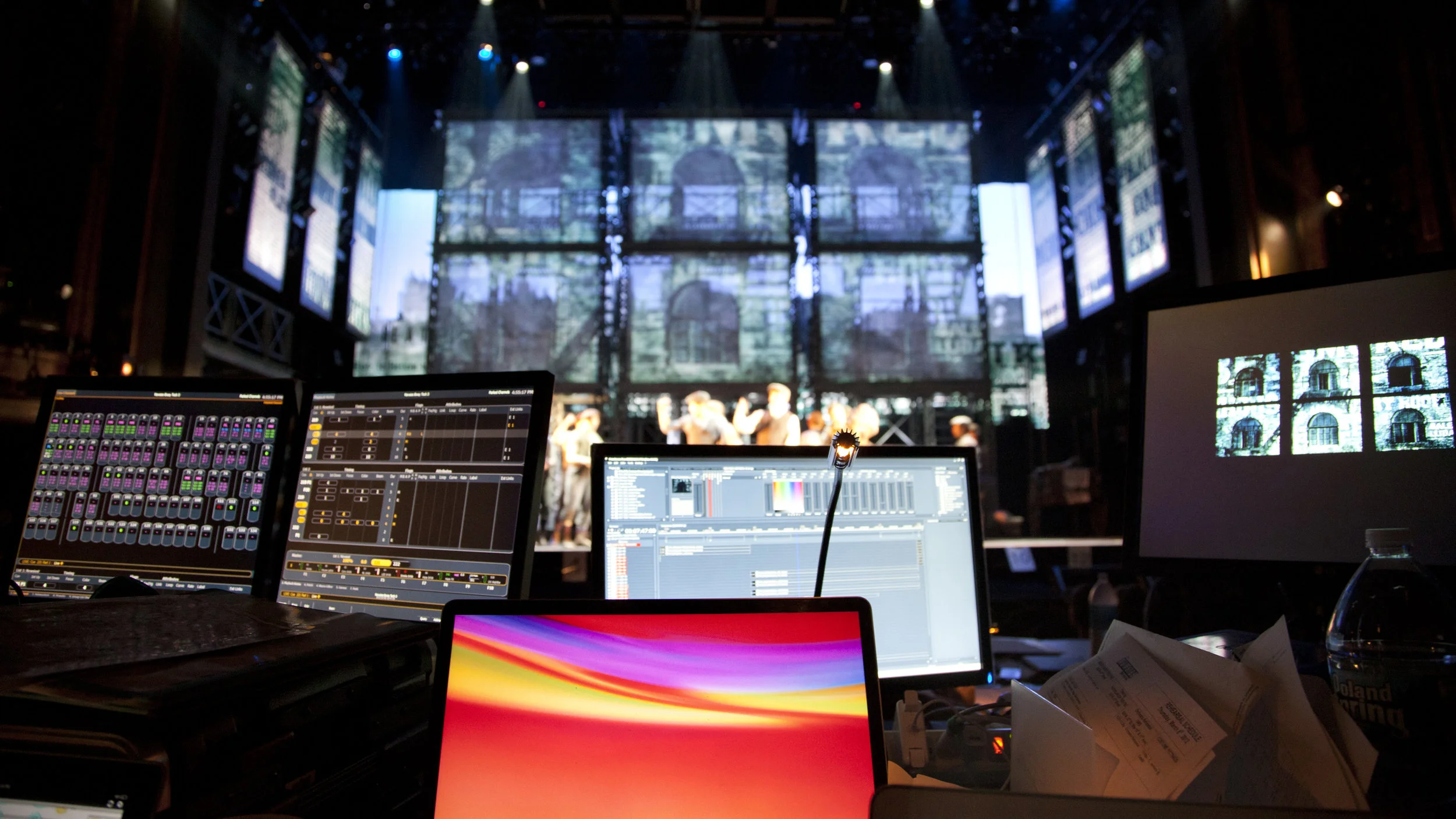Projection Design
Sven's production table in the Nederlander Theater for the Broadway run of Newsies
Projection Design is...
concerned with creating and integrating film, motion graphics, and video technology utilizing cameras, projectors, LED walls or monitors into the fields of theatre, opera, dance, fashion shows, concerts, and other live events. It adds a layer of visual information that conventional design components (sound, lighting, scenery, costume) can not realize. Significantly, projection design is in conversation not just with the other design disciples, but it considers the sequencing of looks, the relationship with live performers, the presence of live audiences, and its relationship to physical spaces.
The imagery production process usually includes the following activities: research, storyboarding, acquisition of images or moving footage, editing, and compositing. The specifics of each activity are very diverse and differ from project to project. The same is true of the installation component of the design, namely the specific choices made on playback equipment, projectors, LED screens, monitors, and cameras.
About the credit:
I got used to calling the work "video design" because that credit had already been used when I started in 2000. Alternatives ranged from "animations" to "visuals" and even "VTR operator." Some of the credits are a symptom of a lack of understanding of the job. Theatres in the UK eventually embraced the "video design" credit. In North America, "projection design" is more common, but neither title fully describes what I do. I find it useful to consider that most credits are clumsy descriptors, but are rooted in the profession's history.
Projection design is an older title that used to be applied to individuals or companies that realize or design different forms of slide projections. This commonly required the strategic placement of projectors and the skillful pre-distortion of the slides to compensate for unusual projection angles created by the architecture of the buildings housing the projections. With advances in computer, projector, and display technology, the term "projection designer" has lost some of its descriptive power.
My creative design process considers both the creation of the artwork and how the artwork will be integrated into to overall visual and physical design of the production. Essential to the design's success is understanding and specifying the most adequate tools for the specific design changes.. A visible, bright, crisp image may necessitate many computers, projectors, and control equipment. I like to be the person that chooses these components because they directly affect the resulting projections. As a projection designer, I need to know how to choose the tools that help me realize my and the creative team's vision. The system's design that delivers the artwork using modern display technologies is a successor to slide projection which was common in the 20th century. This is another reason why I prefer the term "projection design." The tools have changed, and the creative process has developed alongside, but the original intention, to integrate imagery successfully into a unified stage language has remained the same.
Not all projection designers"necessarily have a theatre background, but often come from other fields such as filmmaking, post-production, or graphic design. In those fields, only the content or the imagery is produced as part of the job. Even though I have been practicing it for over two decades, many still consider projection or media design a new field of work. Consequently, those who practice the profession establish many standards and workflows. My process may not be that over another designer; however, this now changes as former students and assistants become established designers in their own right.
It is also important to note that the term projection design or media design describes a skillset and design discipline that is predominantly relevant in the performing arts. Those same skills and techniques are equally relevant in other fields of work, such as event design, virtual production, experience design, or projection mapping.
A brief historical note:
I often read about how "video" or "digital projection" is the latest fad in contemporary theatre. Even some of my colleagues occasionally refer to it as new technology. The German Director Erwin Piscator during the 1920s frequently used movie projectors to enhance his productions. Josef Svoboda's applications from the 1950s are also astounding. Have a look at the timeline section on this site for more relevant history and data on projections design.

